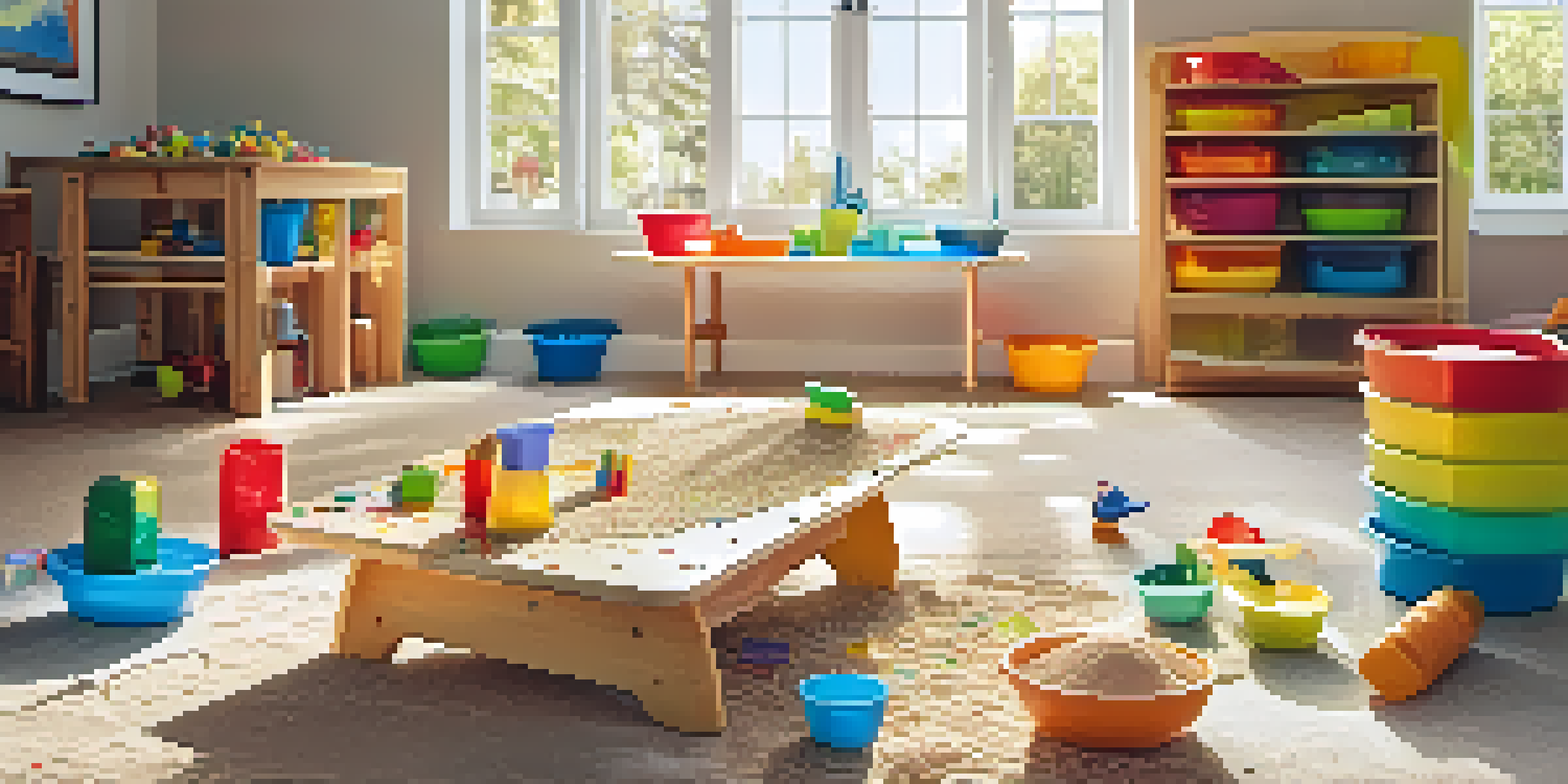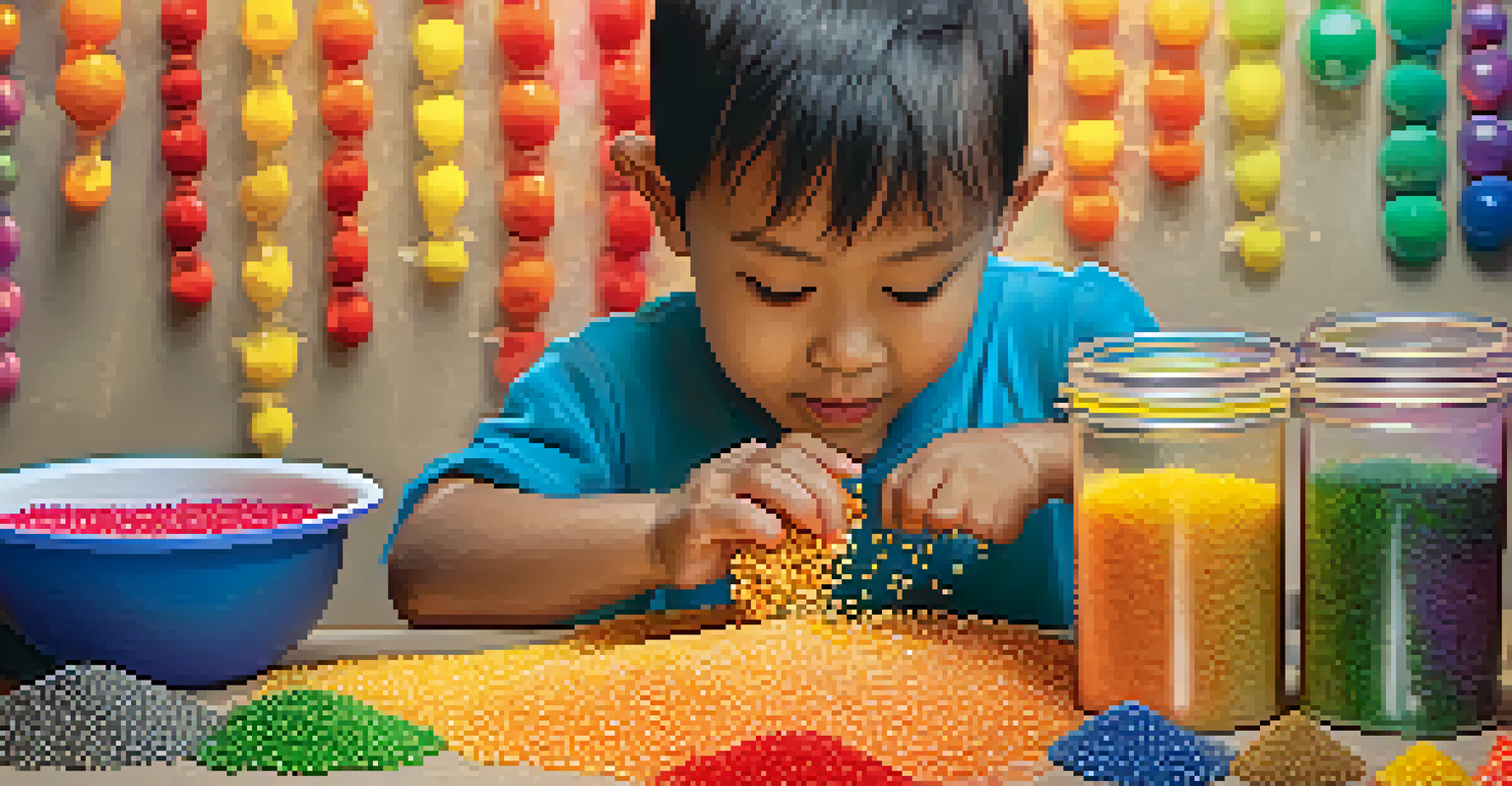The Benefits of Sensory Play for Young Learners

What is Sensory Play and Why is it Important?
Sensory play refers to activities that engage a child's senses: touch, smell, sight, taste, and hearing. This type of play is crucial for young learners as it promotes exploration and discovery. By interacting with different materials, children develop their cognitive skills while also enjoying themselves.
Play is the highest form of research.
For example, playing with sand or water allows children to experience different textures and temperatures. These interactions not only stimulate their senses but also encourage curiosity about the world around them. Sensory play is often seen as a fun activity, but its importance in early development cannot be overstated.
Through sensory play, children learn to express themselves and explore their emotions. This foundational aspect of their development prepares them for more complex learning experiences in the future.
Enhancing Cognitive Development Through Sensory Play
Engaging in sensory play can significantly boost a child's cognitive development. Activities that involve sorting, mixing, or measuring materials challenge young minds to think critically and solve problems. For instance, pouring different liquids into various containers can teach concepts of volume and capacity.

Additionally, sensory play helps improve memory and concentration. When children are actively involved in hands-on activities, they are more likely to retain information and focus on tasks. This type of engagement is essential in building the brain's neural pathways.
Sensory Play Boosts Development
Engaging in sensory play enhances cognitive, fine motor, and social skills in children.
Ultimately, sensory play lays the groundwork for future academic success. By honing their cognitive skills early on, children are better prepared to tackle more complex subjects in school.
Boosting Fine Motor Skills with Hands-On Activities
Fine motor skills are vital for everyday tasks, and sensory play is a fantastic way to develop these abilities. Activities like molding clay or threading beads require precise hand movements, which strengthen the muscles in children's hands and fingers. Over time, this practice leads to improved dexterity and coordination.
Children learn as they play. Most importantly, in play, children learn how to learn.
When young learners manipulate various materials, they enhance their hand-eye coordination as well. For example, pouring rice into a funnel helps them practice timing and control. These skills are not only important for play but also for writing and self-care tasks later in life.
Encouraging children to engage in sensory play with different tools, like tweezers or small scoops, can further refine their fine motor skills. This approach makes learning fun while ensuring they develop the necessary skills for future challenges.
Fostering Social Skills Through Collaborative Play
Sensory play often takes place in group settings, which naturally fosters social skills among young learners. When children engage in activities together, they learn to share, take turns, and communicate their ideas. For example, building a sandcastle as a team encourages collaboration and teamwork.
These interactions provide invaluable opportunities for children to practice empathy and understand different perspectives. By navigating social dynamics during play, they become more adept at forming relationships and resolving conflicts. These early social skills are crucial as they grow and enter school environments.
Emotional Regulation Through Play
Sensory activities help children manage their emotions and express themselves effectively.
Moreover, sensory play can help children express their emotions in a safe setting. When they play together, they can share feelings, whether it's excitement over a new discovery or frustration over a challenge, leading to stronger bonds with their peers.
Encouraging Emotional Regulation and Self-Expression
Sensory play plays a significant role in helping children manage their emotions. Engaging with different textures, colors, and materials can be soothing and provides an outlet for self-expression. For example, squeezing a stress ball can help dissipate feelings of frustration or anxiety.
By experimenting with various sensory materials, children learn to identify and articulate their emotions. For instance, if they feel overwhelmed, they may gravitate toward calming activities like playing with water or sand. This process builds emotional intelligence, which is essential for their overall development.
Additionally, sensory play can serve as a coping mechanism for children. When faced with new or challenging situations, having the tools to engage in sensory activities can provide comfort and help them navigate their feelings.
Promoting Language Development Through Sensory Experiences
Sensory play is not just about physical engagement; it also provides excellent opportunities for language development. As children explore different materials, caregivers can introduce new vocabulary related to their experiences. For instance, discussing colors, textures, and shapes enhances their understanding of language.
Moreover, sensory activities often spark conversations among children, allowing them to practice communication skills. When they describe what they are doing or share their thoughts with peers, they learn to express themselves more clearly. This interaction is crucial for building confidence in their language abilities.
Language Skills via Sensory Experiences
Sensory play provides rich opportunities for children to develop language and communication skills.
Incorporating storytelling into sensory play can further enhance language skills. For example, creating a narrative around a sensory bin filled with various objects encourages imaginative play and vocabulary expansion, transforming a simple activity into a rich learning experience.
Creating a Safe Environment for Sensory Exploration
It's essential to create a safe and inviting space for sensory play to thrive. This means selecting age-appropriate materials and ensuring that the environment is free from hazards. For instance, using non-toxic playdough or safe sensory bins can make all the difference in ensuring a positive experience.
Setting up areas specifically for sensory activities can help establish a routine. This dedicated space allows children to know where they can explore freely without restrictions. Parents and educators can design these areas with various textures and sensory items to keep the engagement high.

Moreover, encouraging children to explore independently within a safe framework fosters their confidence. When they feel secure in their environment, they are more likely to engage in creative exploration and take risks, which is vital for learning and growth.
Integrating Sensory Play into Daily Routines
Integrating sensory play into daily routines can enhance children's overall learning experiences. Simple activities, like creating a sensory bin for dinner prep, can transform mundane tasks into exciting explorations. For example, using rice, beans, or pasta can engage children while you cook.
Incorporating sensory play during transition times can also help children adjust to changes more smoothly. For instance, having a tactile activity available during waiting periods can keep them engaged and calm, making transitions less stressful.
Additionally, parents and caregivers can encourage sensory play at home by providing various materials for exploration. From water tables to art supplies, these everyday items can ignite creativity and learning, making sensory play a natural part of children's lives.